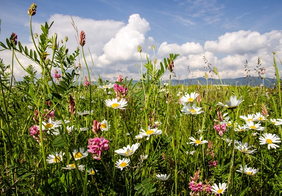Flowering mixtures have become a popular biodiversity measure on farmland. As part of the funding programme for agri-environment, climate protection and animal welfare (FAKT) in Baden-Württemberg, several measures for the establishment of flowering areas are now offered.
In a first study from 2018 on the effect of 1-year flowering areas on flower-visiting insect groups, this was followed two years later by an expansion to multi- and over-year flowering areas. This study was funded by the Ministry of Food, Rural Areas and Consumer Protection Baden-Württemberg (MLR) as part of the evaluation of the Measures and Development Plan for Rural Areas Baden-Württemberg 2014 to 2020 (MEPL III).
The highest numbers of species and individuals of bees, hoverflies and butterflies were observed on perennial flowering areas, followed by annual flowering areas and waste land dominated by grassland. Crops under arable land were the worst performers. Perennial areas provide flowering plants already in spring and also offer nesting and overwintering habitats. All measures in which the area is completely mown and turned over in autumn represent a "breeding trap" for insect nests. So the annual flowering mixtures are by far the most popular among farmers, so that more annual and perennial mixtures should be introduced into the areas.
For an effective promotion of insects, structures - such as extensive grassland, field woods and marginal structures - with a different spectrum of flowering plants and other required features of habitat must also be maintained or re-created.
The study is available at the following link: https://foerderung.landwirtschaft-bw.de/pb/,Lde/Startseite/Agrarpolitik/Begleitstudien
Contact persons at IfLS: Heike Nitsch (nitsch[at]ifls.de), Jörg Schramek (schramek[at]ifls.de
